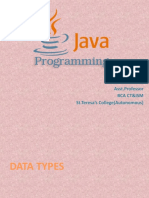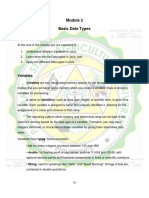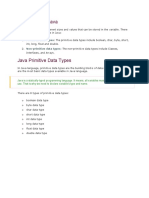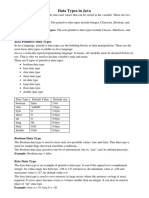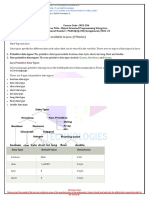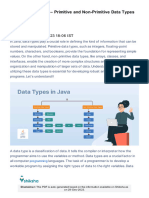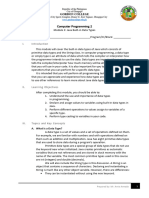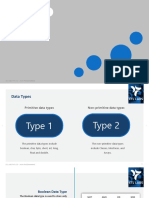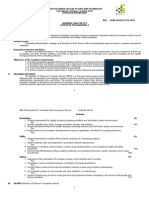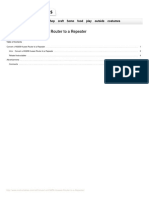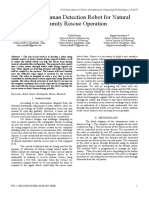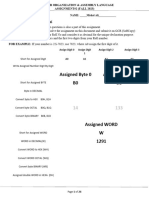Variables are nothing but reserved memory locations to store values.
This means that when you create a variable you reserve some space in
memory.
Based on the data type of a variable, the JVM allocates memory and decides what can be stored in the reserved memory. Therefore, by
assigning different data types to variables, you can store integers, decimals, or characters in these variables.
There are two data types available in Java:
Primitive Data Types
Reference/Object Data Types
Primitive Data Types:
There are eight primitive data types supported by Java. Primitive data types are predefined by the language and named by a key word. Let
us now look into detail about the eight primitive data types.
byte:
Byte data type is a 8-bit signed two's complement integer.
Minimum value is -128 (-2^7)
Maximum value is 127 (inclusive)(2^7 -1)
Default value is 0
Byte data type is used to save space in large arrays, mainly in place of integers, since a byte is four times smaller than an int.
Example : byte a = 100 , byte b = -50
short:
Short data type is a 16-bit signed two's complement integer.
Minimum value is -32,768 (-2^15)
Maximum value is 32,767(inclusive) (2^15 -1)
Short data type can also be used to save memory as byte data type. A short is 2 times smaller than an int
Default value is 0.
Example : short s= 10000 , short r = -20000
int:
Int data type is a 32-bit signed two's complement integer.
Minimum value is - 2,147,483,648.(-2^31)
Maximum value is 2,147,483,647(inclusive).(2^31 -1)
Int is generally used as the default data type for integral values unless there is a concern about memory.
The default value is 0.
Example : int a = 100000, int b = -200000
long:
Long data type is a 64-bit signed two's complement integer.
Minimum value is -9,223,372,036,854,775,808.(-2^63)
Maximum value is 9,223,372,036,854,775,807 (inclusive). (2^63 -1)
This type is used when a wider range than int is needed.
Default value is 0L.
Example : long a = 100000L, int b = -200000L
float:
� Float data type is a single-precision 32-bit IEEE 754 floating point.
Float is mainly used to save memory in large arrays of floating point numbers.
Default value is 0.0f.
Float data type is never used for precise values such as currency.
Example : float f1 = 234.5f
double:
double data type is a double-precision 64-bit IEEE 754 floating point.
This data type is generally used as the default data type for decimal values. generally the default choice.
Double data type should never be used for precise values such as currency.
Default value is 0.0d.
Example : double d1 = 123.4
boolean:
boolean data type represents one bit of information.
There are only two possible values : true and false.
This data type is used for simple flags that track true/false conditions.
Default value is false.
Example : boolean one = true
char:
char data type is a single 16-bit Unicode character.
Minimum value is '\u0000' (or 0).
Maximum value is '\uffff' (or 65,535 inclusive).
Char data type is used to store any character.
Example . char letterA ='A'
Java Literals:
A literal is a source code representation of a fixed value. They are represented directly in the code without any computation.
Literals can be assigned to any primitive type variable. For example:
byte a = 68;
char a = 'A'
byte, int, long, and short can be expressed in decimal(base 10),hexadecimal(base 16) or octal(base 8) number systems as well.
Prefix 0 is used to indicates octal and prefix 0x indicates hexadecimal when using these number systems for literals. For example:
int decimal = 100;
int octal = 0144;
int hexa = 0x64;
String literals in Java are specified like they are in most other languages by enclosing a sequence of characters between a pair of double
quotes. Examples of string literals are:
"Hello World"
"two\nlines"
"\"This is in quotes\""
String and char types of literals can contain any Unicode characters. For example:
�char a = '\u0001';
String a = "\u0001";
Java language supports few special escape sequences for String and char literals as well. They are:
Notation Character represented
\n Newline (0x0a)
\r Carriage return (0x0d)
\f Formfeed (0x0c)
\b Backspace (0x08)
\s Space (0x20)
\t tab
\" Double quote
\' Single quote
\\ backslash
\ddd Octal character (ddd)
\uxxxx Hexadecimal UNICODE character (xxxx)





